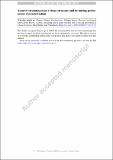| dc.contributor.author | Zhang, Chuanyu | |
| dc.contributor.author | Guo, Xiaofeng | |
| dc.contributor.author | Brunet, Philippe | |
| dc.contributor.author | Costalonga, Maxime | |
| dc.contributor.author | Royon, Laurent | |
| dc.date.accessioned | 2021-09-20T17:16:46Z | |
| dc.date.available | 2021-09-20T17:16:46Z | |
| dc.date.issued | 2019-08-07 | |
| dc.identifier.uri | https://hdl.handle.net/1721.1/131372 | |
| dc.description.abstract | Abstract
Acoustic streaming can be generated in microchannels by low-frequency acoustic transducer in the vicinity of sharp structures. Close to the tip, the strong curvature induces bent trajectories on the time-periodic acoustic flow, locally enhancing the streaming-generating force. In this study, we investigate the influence of the sharp structure and vibration velocity on the streaming flow. The vibration velocities are characterized by directly visualizing the displacement of tracing particles and the generated acoustic streaming is observed using particle image velocimetry, under various operating conditions. By measuring the concentration of a fluorescence dye, we evaluate the mixing performance for different values of tip angle, vibration amplitude, and flow rate through the microchannel. Our results confirm that intense streaming is generated under low-frequency (2.5 kHz) acoustic condition when the local curvature of the boundary is close to or smaller than the viscous boundary-layer thickness. It is shown that the sharpest the edge tip, the largest the vortices size and the spatial extent of the induced streaming, therefore greatly enhancing the mixing between two miscible liquids. The mixing index, linearly characterizing the mixing degree between 1 (totally separated) and 0 (perfectly mixed), jumps from 0.73 (without acoustic excitation) to 0.38 (with acoustic excitation), resulting in a highly mixed homogeneous fluid just after the sharp edge. This emphasizes the promising potential of acoustic streaming to enhance mass transfer inside microchannels which is usually limited by the laminar flow conditions. | en_US |
| dc.publisher | Springer Berlin Heidelberg | en_US |
| dc.relation.isversionof | https://doi.org/10.1007/s10404-019-2271-5 | en_US |
| dc.rights | Article is made available in accordance with the publisher's policy and may be subject to US copyright law. Please refer to the publisher's site for terms of use. | en_US |
| dc.source | Springer Berlin Heidelberg | en_US |
| dc.title | Acoustic streaming near a sharp structure and its mixing performance characterization | en_US |
| dc.type | Article | en_US |
| dc.identifier.citation | Microfluidics and Nanofluidics. 2019 Aug 07;23(9):104 | en_US |
| dc.contributor.department | Massachusetts Institute of Technology. Department of Mechanical Engineering | |
| dc.eprint.version | Author's final manuscript | en_US |
| dc.type.uri | http://purl.org/eprint/type/JournalArticle | en_US |
| eprint.status | http://purl.org/eprint/status/PeerReviewed | en_US |
| dc.date.updated | 2020-09-24T21:03:39Z | |
| dc.language.rfc3066 | en | |
| dc.rights.holder | Springer-Verlag GmbH Germany, part of Springer Nature | |
| dspace.embargo.terms | Y | |
| dspace.date.submission | 2020-09-24T21:03:39Z | |
| mit.license | PUBLISHER_POLICY | |
| mit.metadata.status | Authority Work and Publication Information Needed | |
